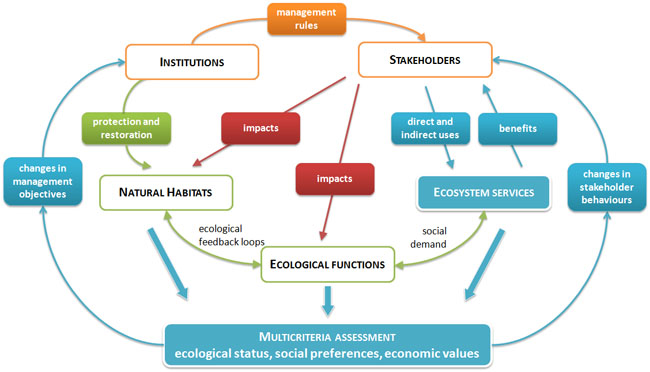2.3.2.3 Triage sequence 1.3: What parts of the marine social-ecological system are concerned by these policy issues?

 TRIAGE SEQUENCE 1
TRIAGE SEQUENCE 1
Preliminary delimitation of the scope of the ecosystem services assessment in relation to its general aims
Question 3
What parts of the marine social-ecological system are concerned by these policy issues?
This stage of the triage process requires specification and selection of the ecosystem components, functions and services that relate to the defined policy issues, as well as the identification of the stakeholders and institutions whose actions are concerned by these policy issues.

Figure: a system view of ecosystem services at the a local level, elaboration after [Mongruel et al., 2015; Braat and de Groot, 2012; Carpenter et al., 2009; Daily et al., 2009; Turner and Daily, 2008]
In response to these sometimes negative effects of human activities, institutions have been designed for managing uses and mitigating impacts.
This conceptual model presents a very simple framework which places the ecosystem services approach within a system view.
Basically, ecosystem services depend on natural habitats and ecological functions, but they exist as long as there is a social demand for the benefits the latter may provide. This demand is expressed by stakeholders, which are responsible for direct and indirect uses of ecosystem services, but also for impacts on habitats and ecological functions.
For many practical reasons, including for the purpose of improving ecosystem governance through realistic management options, it is useful to determine who are the beneficiaries of ecosystem services as well as who is responsible for the impacts.
This framework is designed for assessing ecosystem services at the local scale, therefore the contribution of ecosystem services to human well-being is left aside, as it is a broader question which should be addressed at the global scale . On the other hand, a multicriteria assessment framework which includes ecological status descriptors, social preferences indicators and monetary values would contribute to a first appraisal of the contribution of local ecosystem services to human well-being. Furthermore, the criteria associated with these ecological, social and economic indicators are expected to inform the judgements that society will form regarding the situation, what is likely to affect the current consensus and trends regarding policy objectives and stakeholder behaviours.
The system view is necessary for implementing an ecosystem services process and to run a scenario building. It can be approached using a variety of tools to collect information and represent the system.
Tools
 Interviews
Interviews ![]()
 Brainstorming
Brainstorming ![]()
 Stakeholder matrix
Stakeholder matrix ![]()
 Tools to represent the system, present and combine information, synthesize knowledge
Tools to represent the system, present and combine information, synthesize knowledge ![]()

